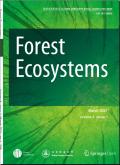中国北方落叶乔木种植园的混合生态生理生长模型
IF 3.8
1区 农林科学
Q1 FORESTRY
引用次数: 0
摘要
短轮伐期人工林(SRF)正被广泛采用来提高木材产量,以满足全球对木材产品的需求。然而,为了确保从 SRF 中获得最大收益,需要结合可靠的预测和对树木生长内在机制的了解来建立优化的管理机制。混合生态生理学模型(如潜在可用光和方程(PULSE)模型)是一种有用的工具,只需最少的输入数据,即可满足自流森林的要求。PULSE 模型已经过测试和校准,适用于不同常绿针叶树和阔叶树在幼树和成熟阶段的生长,并使用了粗略的土壤和气候数据。因此,我们不禁要问:增加详细的土壤和气候数据能否减少这类模型的误差?此外,PULSE 技术尚未用于落叶树种建模,而落叶树种的物候学特征对生态生理模型来说是一个挑战。本研究利用详细的土壤和气候数据,为中国北方的一个克隆杨种植园开发了一个 PULSE 模型。结果表明,高度(米)和基部面积(平方米-公顷-1)的预测精度高、偏差小。虽然详细的气候数据能产生高精度的预测和良好的机理理解,但该研究建议也可采用当地的气候数据。研究表明,PULSE 建模与粗略的自然环境数据和当地气候数据相结合,可实现相当精确的树木生长预测,且偏差极小。本文章由计算机程序翻译,如有差异,请以英文原文为准。
Hybrid ecophysiological growth model for deciduous Populus tomentosa plantation in northern China
Short rotation plantation forestry (SRF) is being widely adopted to increase wood production, in order to meet global demand for wood products. However, to ensure maximum gains from SRF, optimised management regimes need to be established by integrating robust predictions and an understanding of mechanisms underlying tree growth. Hybrid ecophysiological models, such as potentially useable light sum equation (PULSE) models, are useful tools requiring minimal input data that meet the requirements of SRF. PULSE models have been tested and calibrated for different evergreen conifers and broadleaves at both juvenile and mature stages of tree growth with coarse soil and climate data. Therefore, it is prudent to question: can adding detailed soil and climatic data reduce errors in this type of model? In addition, PULSE techniques have not been used to model deciduous species, which are a challenge for ecophysiological models due to their phenology. This study developed a PULSE model for a clonal Populus tomentosa plantation in northern China using detailed edaphic and climatic data. The results showed high precision and low bias in height (m) and basal area (m2·ha−1) predictions. While detailed edaphoclimatic data produce highly precise predictions and a good mechanistic understanding, the study suggested that local climatic data could also be employed. The study showed that PULSE modelling in combination with coarse level of edaphic and local climate data resulted in reasonably precise tree growth prediction and minimal bias.
求助全文
通过发布文献求助,成功后即可免费获取论文全文。
去求助
来源期刊

Forest Ecosystems
Environmental Science-Nature and Landscape Conservation
CiteScore
7.10
自引率
4.90%
发文量
1115
审稿时长
22 days
期刊介绍:
Forest Ecosystems is an open access, peer-reviewed journal publishing scientific communications from any discipline that can provide interesting contributions about the structure and dynamics of "natural" and "domesticated" forest ecosystems, and their services to people. The journal welcomes innovative science as well as application oriented work that will enhance understanding of woody plant communities. Very specific studies are welcome if they are part of a thematic series that provides some holistic perspective that is of general interest.
 求助内容:
求助内容: 应助结果提醒方式:
应助结果提醒方式:


